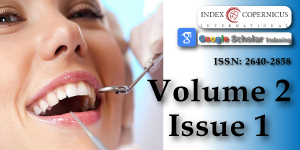Preventing Peri-implantitis with a proper Cementation Protocol and with the consideration of alternatives to Cement-Retained Implant Restorations
Main Article Content
Abstract
Successful implant restoration is depending on an adequate surgical and prosthetic protocol. In the last few years an increase in Peri-Implantitis has been attributed, in part, to the excess cement left around the implant collar and threads, leading in many cases to bone loss and even the complete failure of the implant treatment [1-5].
This article will attempt: 1. To describe a proper cementation protocol for cement-retained implant restorations to reduce cement induced implant failures, and 2. To review the alternative implant restorative options to cement-retained crowns such as screw-retained restorations, screwless and cementless implant restorations, screw-retained-cemented implant crown, angulated screw channel restorations, the lingual locking screw-retained restorations and the multi-unit abutment restorations.
Article Details
Copyright (c) 2018 Daher T, et al.

This work is licensed under a Creative Commons Attribution 4.0 International License.
Wadhwani C. Prosthetic options for Dental implants. Decisions in dentistry. 2016; 24-26. Ref.: https://goo.gl/zynSXs
Dumbrigue HB1, Abanomi AA, Cheng LL. Techniques to minimize excess luting agent in cement-retained implant restorations. JPD. 2002; 87: 112-114. Ref.: https://goo.gl/efKXbg
Wadhwani C1, Piñeyro A. Technique for controlling the cement for an implant crown: J Prosthet Dent. 2010; 102: 57-58. Ref.: https://goo.gl/SzDTBB
Wilson TG. The positive relationship between excess cement and peri-implant disease: a prospective clinical endoscopic study. J Periodontol. 2009; 80: 1388-1392. Ref.: https://goo.gl/mxBZon
Reznic J. Evaluation and management of common dental implant complications. Implant Practice. 8: 6: 36-42. Weber HP, Kim DM, Ng MW, Hwang JW, Fiorellini JP. Peri-implant soft-tissue health surrounding cement- and screw-retained implant restorations: a multi-center, 3-year prospective study. Clin Oral Implants Res. 2006; 17: 375-379. Ref.: https://goo.gl/xT8H2U
Sherif S, Susarla HK, Kapos T, Munoz D, Chang BM, et al. A systematic review of screw- versus cement-retained implant-supported fixed restorations. J of Prosthodont. 2014; 23: 1–9. Ref.: https://goo.gl/CTG6At
Urdaneta RA, Marincola M. The Integrated Abutment Crownä, a screwless and cementless restoration for the single-tooth implants: a report on a new technique. J Prosthodont. 2007; 16: 311-318. Ref.: https://goo.gl/bRE52e
Urdaneta RA, Marincola M, Weed M, Chuang SK. A screwless and cementless Technique for the Restoration of Single-Tooth Implants: A Retrospective Cohort Study. J Prosthodont. 2008; 17: 562-571. Ref.: https://goo.gl/kMbVKv
Berroeta E, Zabalegui I, Donovan T, Chee W. Dynamic Abutment: A method of redirecting screw access for implant-supported restorations: Technical details and a clinical report. J Prosthet Dent. 2015; 113: 516–519. Ref.: https://goo.gl/iQzbsa
Clausen GF. The lingual locking screw for implant-retained restorations--aesthetics and retrievability. Aust Prosthodont J. 1995; 9: 17-20. https://goo.gl/xdD6Dx
Daher T, Morgano SM. The use of digital photographs to locate implant abutment screws for implant-supported cement-retained restorations. J Prosthet Dent. 2008; 100; 3: 238-239. Ref.: https://goo.gl/Gp2A6F
Gervais MJ, Hatzipanagiotis, Wilson PR. Cross-pinning: the philosophy of retrievability applied practically to fixed, implant-supported prostheses. Aust Dent J. 2008; 53: 74-82. Ref.: https://goo.gl/FePySz





